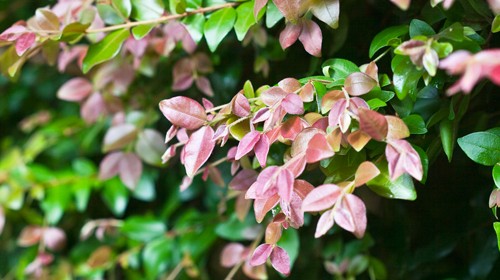The lilly pilly is one of the most popular plants in Australia today, particularly for hedging and topiary.
Lilly pillies are evergreen rainforest plants with glossy green leaves. Many varieties have flushes of colourful new growth, ranging from brilliant pink to a red-brown. In spring to early summer most lilly pillies have fluffy white or greenish flowers followed by long lasting red, purple or whitish berries. There are many, many species and cultivars on the market. Of these, a few are misnamed, while some perform better than others in gardens.
Confusion over names
Once lilly pillies were all known as eugenias. In recent years botanists have divided them into several genera, including Acmena, Syzygium and Waterhousea. Adding to the confusion, many growers have given lilly pillies marketing names. Sometimes the same plant will have several names. For example the lilly pilly sold as ‘Elite’ is thought to be identical to one sold as ‘Aussie Compact’. As well, some plants are sold under the wrong botanic name. Many lilly pillies for example are labelled Syzygium paniculatum, but are actually forms of S. australe. It is very important that these plants are correctly identified, particularly when they are used mainly as foliage plants, and the foliage of some species is very susceptible to attack by a pest called the lilly pilly psyllid.
Pimply problems
The lilly pilly psyllid (Trioza eugeniae) is a tiny native insect related to cicadas. The immature psyllids or nymphs feed inside the leaves. They settle in one spot then embed themselves in the leaf, forming a lump or pimple. This is a disfiguring problem and the last thing you want to see on your stylish hedge or topiary. Some lilly pillies are not worried by the pimple psyllid. The most resistant varieties are Acmena smithii and Syzygium luehmannii. Those that most readily show signs of attack are Syzygium paniculatum types including ‘Lillyput’. Waterhousea floribunda is also susceptible. Plants in nurseries don’t usually show signs of psyllid damage as they are sprayed regularly as a protective measure. As the pest is inside the leaf, contact sprays are not effective. Control is usually gained with a systemic spray such as Confidor.
Burke’s Backyard Best Lilly Pillies
‘Burke’s Backyard’ has assessed the huge range of lilly pillies, selected those best suited to garden use and arranged them by size. All of the plants chosen should be resistant to, or rarely affected by, the lilly pilly psyllid.
Big (5m+)
Acmena smithii var. minor Syzygium luehmannii
Both are resistant to psyllids
Middle Sized (3-5m)
Syzygium australe ‘Bush Christmas’ (psyllid prone), S. australe ‘Elite’ (psyllids possible), Acmena smithii ‘Hot Flush’ (no psyllids), S. australe ‘Aussie Southern’ (psyllids possible)
Little (under 2m)
Syzygium luehmannii ‘Royal Flame’ (resistant to psyllids)
Tiny (under 1m)
Syzygium australe ‘Tiny Trev’ (psyllids possible), Acmena smithii ‘Hedgemaster’ (resistant to psyllids)
Further information
‘Hedgemaster’ (the variety produced by Don Burke) is available now at nurseries Australia wide. 140mm (5 1/2″) pots cost around $10-$11.
We filmed our story on “Best Lilly Pilly Varieties” at Wirreanda Nursery, 169 Wirreanda Road, Ingleside, NSW, 2101. Phone (02) 9450 1400 Fax: (02) 9450 2664 Email: [email protected]



